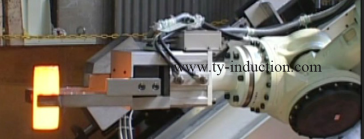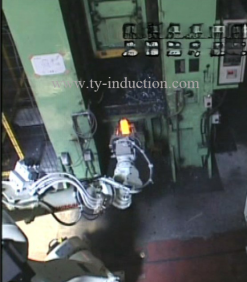Robotic Loading and Unloading Becoming Standard in Forging Workshops
August 14, 2025
The forging industry is entering a new era of automation, driven by the need for higher productivity, improved safety, and consistent product quality. Among the most transformative trends is the widespread adoption of robotic systems for loading and unloading billets, components, and finished parts. This shift is complemented by the increasing integration of advanced Induction Heating System for Forging, which ensures precise and efficient heating of materials before they are processed. What was once considered a luxury or experimental setup is now rapidly becoming a standard feature in modern forging workshops.
This shift reflects growing pressures from labor shortages, rising production demands, and the need for precise handling of increasingly complex and high-value materials.

Traditional forging processes involve extreme heat, heavy components, and repetitive manual handling—posing significant challenges:
· Safety Risks: Workers face burns, crushing hazards, and long-term physical strain.
· Labor Shortages: Skilled operators are increasingly scarce and difficult to retain.
· High Throughput Demands: Tight production schedules require fast, consistent material handling.
· Quality Variability: Manual inconsistencies can lead to defects, dimensional inaccuracies, or rework.
Robotic systems directly address these challenges by delivering reliable, repeatable, and safe part handling across the entire forging process—from billet heating to final cooling.

Robots eliminate human exposure to high temperatures, heavy machinery, and hazardous environments. This significantly reduces workplace injuries and supports compliance with occupational safety standards.
· Robots operate 24/7 with consistent cycle times
· Faster than human operators, reducing bottlenecks
· Enable multi-shift operations with minimal supervision
Result: Up to 30% faster throughput and reduced idle time.
· Programmable motion paths ensure accurate billet placement
· Precision grippers maintain alignment during transfer
· Reduces variability in heating, forging, and cooling phases
Outcome: Improved dimensional accuracy and fewer defects.
Modern robotic arms can be reprogrammed for different part geometries, weights, and production sequences. This enables quick changeovers and supports mixed-model production lines without major retooling.
While the initial investment is significant, long-term savings are substantial:
· Lower labor dependency
· Reduced scrap rates (up to 15–20%)
· Fewer quality-related reworks
· Predictable maintenance and downtime
ROI is typically achieved within 2–4 years, depending on volume and labor costs.
Robotic systems are now integrated across multiple stages of the forging process:
Application | Function |
Billet Loading | Robots feed billets into induction heaters or furnaces with precise timing and positioning |
Part Unloading | Extract forged components from presses or dies immediately after forming |
Transfer & Handling | Move parts between heating, forging, trimming, and cooling stations |
Cooling & Stacking | Place hot parts onto cooling racks or conveyor systems safely and uniformly |
Automated Inspection | Integrate vision systems or sensors for real-time quality checks before next-stage processing |
When fully integrated, these functions enable end-to-end automation, minimizing human intervention.
The global decline in skilled labor is accelerating automation. Robots allow workshops to maintain high output with fewer operators.
Forging aluminum, titanium, and specialty alloys demands extreme precision to avoid surface damage or distortion. Robots provide the consistency that manual handling cannot match.
Robotic systems can be connected to:
· MES (Manufacturing Execution Systems)
· Predictive maintenance platforms
· Real-time quality control systems
· Digital twin simulations
This enables data-driven decision-making and full process traceability.
Automated forging lines deliver:
· Lower defect rates
· Shorter lead times
· Higher repeatability
These advantages are critical for winning contracts in aerospace, automotive, and energy sectors.
A manufacturer of high-precision drive shafts and transmission parts implemented robotic loading/unloading across its forging line. Results included:
Metric | Improvement |
Cycle Time | Reduced by 20–30% |
Scrap Rate | Decreased by 15% |
Safety Incidents | Eliminated manual handling of heated billets |
Shift Flexibility | Enabled 3-shift operation with only 2–3 supervisors |
OEE (Overall Equipment Effectiveness) | Increased from 68% to 89% |
Takeaway: Robotics is not just a labor-saving tool—it’s a quality, safety, and productivity multiplier.
When deploying robotic systems, workshops should evaluate:
Factor | Key Questions |
Payload & Reach | Can the robot handle the heaviest and longest parts in the workflow? |
End-of-Arm Tooling (EOAT) | Are grippers heat-resistant and adaptable to various shapes? |
System Integration | Can the robot synchronize with furnaces, presses, and conveyors? |
Programming & Flexibility | Is the system easy to reprogram for new products? |
Safety Compliance | Are light curtains, emergency stops, and safety enclosures in place? (e.g., ISO 10218, CE) |
· Sustainability: Reduced scrap and energy waste support ESG goals
· Predictable Maintenance: Robots generate operational data for preventive servicing
· Scalability: Easier to scale production without hiring additional skilled labor
· Quality Assurance: Consistent handling minimizes human-induced defects
Trend | Impact |
Collaborative Robots (Cobots) | Enable human-robot collaboration in smaller or flexible workshops |
AI-Enhanced Handling | Real-time detection of part orientation, temperature, and weight for adaptive control |
Fully Automated Forging Lines | Robots as the central nervous system linking heating, forging, inspection, and packaging |
Global Standardization | Robotic loading/unloading will become a baseline expectation, not a premium option |
Robotic loading and unloading systems are no longer optional—they are essential for modern, competitive forging operations. They deliver:
· Faster production cycles
· Improved worker safety
· Higher product consistency
· Reduced labor dependency
· Lower operational costs over time
As the industry evolves, automation is not just about replacing labor—it’s about redefining what’s possible in precision, efficiency, and scalability.
Workshops that embrace robotic handling today will be best positioned to lead in the era of smart manufacturing and high-performance materials.
TY INDUCTION supports forging workshops in adopting automation with:
· Expertise in integrating high-precision robotic handling systems
· Seamless compatibility with induction heating and forging presses
· Data-enabled monitoring and control platforms
· Full lifecycle support and training
We help you increase throughput, reduce risk, and prepare your facility for the next generation of materials and production demands.
Hot Products
Contact Us
Enquiry hotline:
+86 135 4128 7190
Email:
Address:
No.18,14th Floor, Building 2, No. 169 Zhongli Road, Banzhuyuan Subdistrict, Xindu District, Chengdu, Sichuan, China, Code:610000
